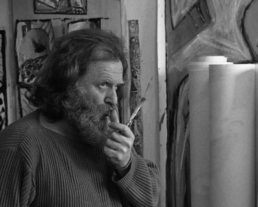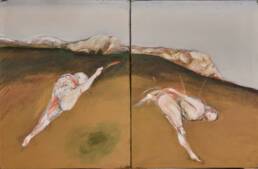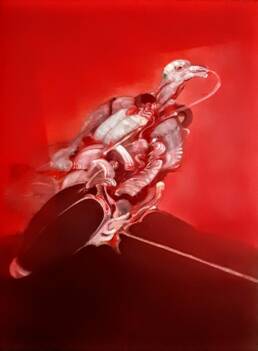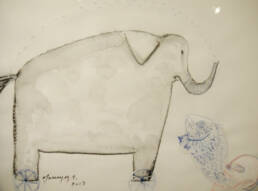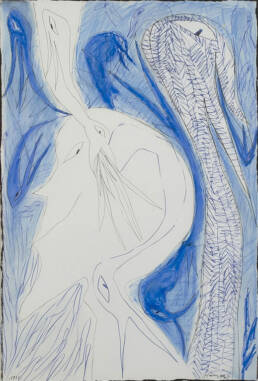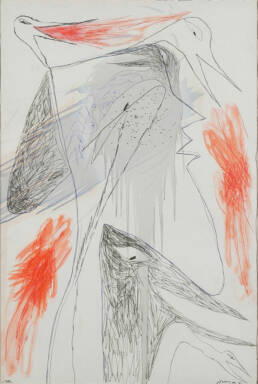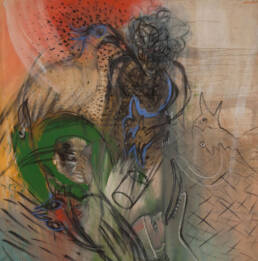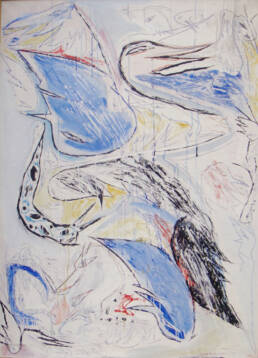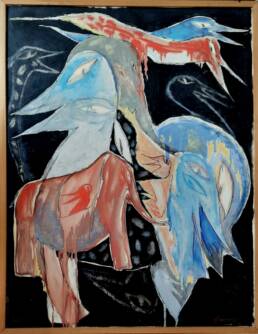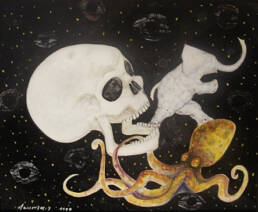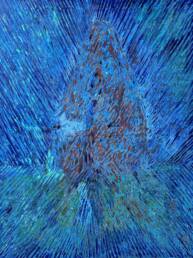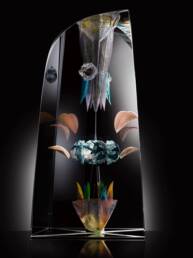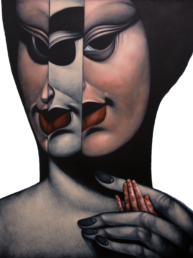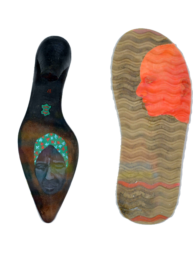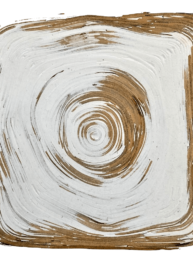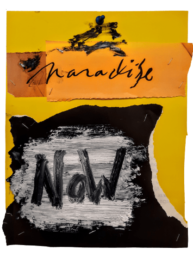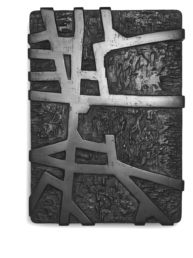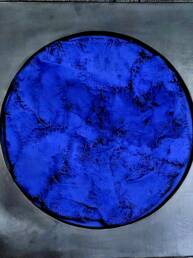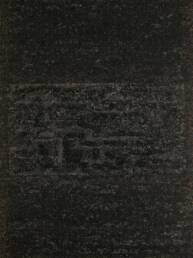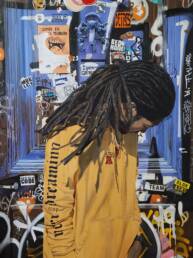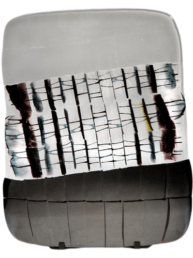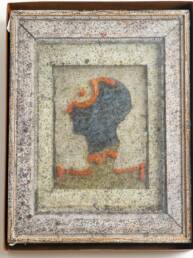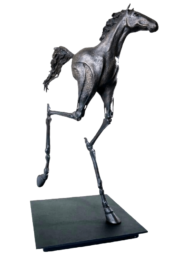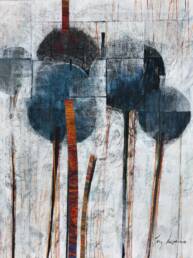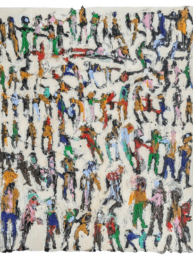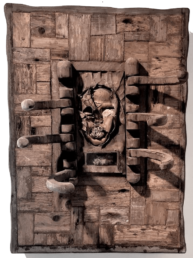Yvan DAUMAS
Daumas' work, in its sensual generosity, stages a whole surrealist bestiary that Bosch would not have disowned. Daumas' gesture is accomplished in a pagan mythology; he confronts us, without preamble, with a world populated by grinning heads, giggling skulls, reptile-birds and fungiform silhouettes bathed in humus, mire and the murkiness of mixed waters. With his sober, powerful, incisive line, Daumas tries, in his own way, to settle his accounts with death and madness.
Yvan Daumas' works have been acquired by important museums, art centres and prestigious private collections.
Yvan DAUMAS
Daumas' work, in its sensual generosity, stages a whole surrealist bestiary that Bosch would not have disowned. Daumas' gesture is accomplished in a pagan mythology; he confronts us, without preamble, with a world populated by grinning heads, giggling skulls, reptile-birds and fungiform silhouettes bathed in humus, mire and the murkiness of mixed waters. With his sober, powerful, incisive line, Daumas tries, in his own way, to settle his accounts with death and madness.
Yvan Daumas' works have been acquired by important museums, art centres and prestigious private collections.
Yvan Daumas, silences and transgressions
Among his generation at the Place Carli, Yvan Daumas was the most gifted artist. Marcel Maréchal had commissioned him to design a poster, sets and costumes for a production of "Falstaff" at the Gymnase. He died on the night of 13 April.
His build and figure, his long hair and red beard, his unrestrained laughter and mischievous eyes will not be forgotten. His father, who was a communist activist, worked as a fisherman. Born in 1943, Yvan Daumas spent his childhood and summers in Carry-le-Rouet: "He knew how to swim and dive before he learned to walk", as they say. His diploma from the Beaux-Arts in Place Carli places him at the heart of a generation that asserted itself around 1968. Among his close friends, Jean-Jacques Surian, Michèle Sylvander and his great friend Pascal Verbena are still active; Jean-Jacques Ceccarelli died in April 2017.
The happiest moments of his career were between 1972 and the early 1980s. The gallery owners of his time - Jean Puech and Jean-Luc Sarre in the basement of the bookshop La Touriale, Jean-Pierre Alis from Athanor, Noëlla Gest in Saint-Rémy-de-Provence, André Nègre and Maurice Mistre in the vicinity of Cours d'Estienne d'Orves, and later the Artothèque Artaud and 10 rue des Marseillais - loved his generosity, his transgressions and his humour.
His most intimate tumults, his violence and savagery, the eruptions of his sensitivity were manifested in his painting. Except for brief forays into the rue de Seine in Paris and Pierre Chave's house in Vence, Yvan Daumas was never able to escape the provincialism of Marseilles. Some of his works were acquired by museums when Marielle Latour and Germain Viatte were directors.
In the early days, accidents and references recalled Francis Bacon and the Cobra movement. After that, an astonishing fluidity, gouaches and mixed techniques, slashes and swirls of colour gave rise to perfectly singular sensations and grammar: on his canvases, we discovered shivers, joys and frights, birds' beaks and profiles, birds of prey or palmipeds, elephants unconcerned with the laws of gravity, beasts of Lascaux and sea serpents. Later on, he carved sumptuous skulls for canes carved from wood.
« Look and close your eyes ! »
No illusions about the social contract, Yvan Daumas did not want to become a "professional". Other pleasures - for example, long hikes in search of mushrooms - periods of silence and inactivity could immobilize him for a long time. He had settled in La Fève, near Allauch; cherry trees, jujube trees and vines as well as a breeding farm of pigeons, chickens and golden pheasants occupied him. During Robert P. Vigouroux's term of office, Dominique Wallon wanted him to teach at Menpenti for adults at the Luminy-Beaux-Arts extra-curricular centre. His friend Claude Langlois told me that when his students asked him for advice, he often repeated that it was necessary to look and close one's eyes, "to let go, to paint with the eyes, with the hands".
A legend begins, it was his third heart attack. Yvan Daumas died during the night of Tuesday 13 April. For his last hours he listened to Léo Ferré, "Merde à Vauban", "La Mémoire et la Mer"; his wife Michèle and his son Yan were here.
Article published in the daily newspaper La Marseillaise by Alain Paire, the 15th April 2021
© Photo credit : Patrick Box
- 1962 : Studies at the Ecole des Beaux Arts in Marseille
- 1967 : Student of François BRET, in contact with the painters Jacques BUSSE and Mario PRASSINOS
- 1965 : Claverie Prize
- 1966 : Lefranc Prize
- 1967 : Torrents Prize
- 1968 : Execution of frescoes for the municipal crèche in the Panier district of Marseille (La Piscine, Le Football)
- 1969 : First Grand Prix of the Avignon Festival
- 2013 : Within the framework of Marseille European Capital of Culture - « 13 Passeurs d'Emotion » from 6 to 31 May - Galerie Bartoli - Marseille (Olivier BERNEX, Robert Blanc, Jean Jacques CECCARELLI, Nisou Costa, Yvan DAUMAS, Georges GUYE, Claude LANGLOIS, Françoise MARTINELLI, Alain PUECH, Jean Paul PORTES, Jean Jacques SURIAN, Pascal VERBENA, Jean Marie ZAZZI)
- 1991 : Alphonse Chave Gallery – Vence
« Plaque Tournante » Marc Tomkins (Choreographer)
"Bureau Concept" Exhibition Centre - Paris
Gallery Serrero – Marseille
Chapel of the Convent - Marseille - 1990 : "Transit" Summer in Marseille, Jardin Zoologique - Marseille
Pébéo factory (Inauguration) - Marseille
Poster for Cripure - National Theater of Marseille
Inauguration of the Théâtre Toursky - Marseille (in collaboration with the I'AM group)
"La Planète ébranlée " Poster Cinéma l'Alhambra (Estaque) - Marseille
Alphonse Chave Gallery – Vence - 1989 : « Art Sud » – Marseille
Art Jonction International – Chave Gallery – Nice
Bernardines theater – Marseille
Alphonse Chave Gallery – Vence - 1988 : Saint Victor Biennial - Marseille
Arthoteca Antonin Artaud – Marseille
Alphonse Chave – Vence
Contemporary Presence - Aix en Provence
Art Jonction – Nice - 1987 : Contemporary Art Centre - Lacoux
Cantini Museum – Marseille - 1985 : « Rites du Vertige » Suspect Gallery – Amsterdam
Ethik Gallery « Oblets de Peintres » – Marseille - 1982 : "Galileo Exhibition" la Criée Theater - Marseille
« Lieux du Corps » – Gardanne
« Marseille sur Seine » Athénains theater – Paris - 1980 : Children's Museum - Vieille Charité - Marseille
Contemporary Presence - Aix en Provence
«10 years of contemporary creation » Musée Cantini - Marseille
"Lieux d'artistes " Ateliers de Lorette - Marseille (Exhibition organised by the Centre Georges Pompidou) - 1978 : College of Contemporary Exchanges - Saint Maximin
- 1977 : "Assessment of the aid for the first exhibition " Graphic Arts Foundation and Plastic - Paris
- 1976 : Influx Gallery – Marseille
- 1975 : « Six Days of Painting » - Marseille
- 1972 : Contemporary Art Group - La Seyne sur Mer
- 1971 : "100 Provençal Artists" - Cantini Museum - Marseille
Goethe Institut – Marseille
Noella Gest Gallery – Saint Rémy de Provence
House of Culture – Saint Étienne - 1968 : Chante Belle – Lubéron
Plastic Art Group - Salon de Provence

